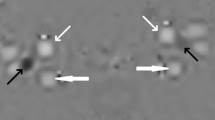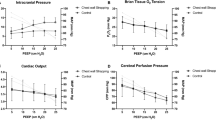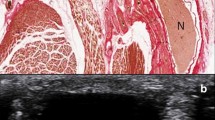Summary
Using anaesthetized spontaneously breathing cats, intracranial pressure (ICP) was monitored for twenty hours following the insult of cold injury; simultaneous recordings were also made of cerebral blood flow (CBF), epidural pulse waveform (EDP-WF), and systemic arterial pressure (SAP). Results could be divided into two groups depending on whether or not ICP exceeded 30 mmHg. In group one, in which marked increase in ICP including occasional episodes of pressure waves were observed, an initial increase in CBF and the changes in EDP-WF from polyphasic to monotonous at about 20 mmHg were characteristic. On the other hand, in group two, ICP never exceeded 30 mmHg, CBF slightly and continuously decreased and EDP-WF was polyphasic throughout the course. There were no significant differences in trends in SAP, in the extent of spread of oedema and in water content of the white matter between both groups. Therefore, the amount of cerebral blood volume (CBV) due to cerebral vasodilatation was considered to account for the further increase in ICP. Moreover, changes in EDP-WF were regarded as a useful indicator in predicting the trends in ICP since these changes could be observed in a relatively lower pressure range prior to a marked increase in ICP.
Similar content being viewed by others
References
Baethmann, A., Ottinger, W., Rothenfusser, W., Kempski, O., Unterberg, A., CSP-pressure of rats during ventriculo-cisternal perfusion with potential brain edema factors. In: Intracranial Pressure IV (Shulman, K.,et al., eds.), pp. 291–297. Berlin-Heidelberg-New York: Springer. 1980.
Barritault, L., Rimbert, J. N., Hirsch, J. F., Pierre-Kahn, A., Lacombe, J., Zouaoui, A., Mises, J., Gabersek, V., Vasomotor origin of intracranial pressure waves in hydrocephalic infants. Eur. J. Nucl. Med.5 (1980), 511–514.
Beks, J. W. F., Kerckhoffs, H. P. M., Studies on the water content of cerebral tissues and intracranial pressure in vasogenic brain oedema. In: Intracranial Pressure (Brock, M.,et al., eds.), pp. 119–126. Berlin-Heidelberg-New York: Springer. 1972.
Brock, M., Furuse, M., Weber, R., Hasuo, M., Dietz, H., Brain tissue pressure gradients. In: Intracranial Pressure II (Lundberg, N., et al., eds.), pp. 215–220. Berlin-Heidelberg-New York: Springer. 1975.
Bruce, D. A., Vapalahti, M., Schutz, H., Langfitt, T. W., rCBF, CMRO2 and intracranial pressure following a local cold injury of the cortex. In: Intracranial pressure (Brock, M.,et al., eds.), pp. 85–89. Berlin-Heidelberg-New York: Springer. 1975.
Clasen, R. A., Brown, D. V. L., Leavitt, S., Hass, G. M., The production by liquid nitrogen of acute closed cerebral lesions. Surg. Gynec. Obstet.96 (1953), 605–616.
Clasen, R. A., Sky-Peck, H. H., Pandolfi, S., Laing, I., Hass, G. M., The chemistry of isolated edema fluid in experimental cerebral injury. In: Brain Edema (Klatzo, I.,et al., eds.), pp. 536–553. Wien-New York: Springer. 1967.
Dewey, R. C., Pieper, H. P., Hunt, W. E., Experimental cerebral hemodynamics. Vasomotor tone, critical closing pressure, and vascular bed resistence. J. Neurosurg.41 (1974), pp. 597–606.
Frei, H. J., Wallenfang, Th., Poll, W., Reulen, H. J., Schubert, R., Brock, M., Regional cerebral blood flow and regional metabolism in cold induced oedema. Acta Neurochir. (Wien)29 (1973), 15–28.
Gazendam, J., Go, K. G., van Zenten, A. K., Composition of isolated edema fluid in cold-induced brain edema. J. Neurosurg.51 (1979), 70–77.
Go, K. G., Zijlstra, W. G., Flanderijn, H., Zuiderveen, F., Circulatory factors influencing exudation in cold-induced cerebral edema. Exp. Neurol.42 (1974), 332–338.
Go, K. G., Zuiderveen, F. Kuipers-de Jager, T. I., Responces of cortical vein wedge pressure, ventricular fluid pressure, and brain tissue pressure to elevation of arterial blood pressure under conditions of hyperventilation and freezing injury to the brain. In: Intracranial Pressure II (Lundberg, N.,et al., eds.), pp. 5–9. Berlin-Heidelberg-New York: Springer. 1975.
Hamer, J., Alberti, E., Hoyer, S., Wiedemann, K., Influence of systemic and cerebral factors on the cerebrospinal fluid pulse waves. J. Neurosurg.46 (1977), 36–45.
Hirai, O., Ishikawa, M., Handa, H., Changes of epidural pulse waveform in increased intracranial pressure: An experimental study. Brain and Nerve33 (1981), 1235–1242.
Hirai, O., Handa, H., Ishikawa, M., Intracranial pressure pulse waveform: Consideration about its origin and methods of estimating intracranial pressure dynamics. Brain and Nerve34 (1982), 1059–1065.
Hirai, O., Handa, H., Ishikawa, M., Kim, S. H., Epidural pulse waveform as an indicator of intracranial pressure dynamics. Surg. Neurol.21 (1984), 67–74.
Klatzo, I., Piraux, A., Laskowski, E. J., The relationship between edema, bloodbrain-barrier and tissue elements in a local brain injury. J. Neuropath, exp. Neurol.17 (1958), 548–564.
Kuschinsky, W., Wahl, M., Bosse, O., Thurau, K., Perivascular potassium and PH as determinants of local pial arterial diameter in cats. A microapplication study. Circ. Res.31 (1972), 240–247.
Lassen, N. A., The luxury-perfusion syndrome and its possible relation to acute metabolic acidosis localized within the brain. Lancet2 (1966), 1113–1115.
Marmarou, A., Shulman, K., Shapiro, K., Poll, W., The time course of brain tissue pressure and local CBF in vasogenic edema. In: Dynamics of Brain Edema (Pappius, H. M.,et al., eds.), pp. 113–121. Berlin-Heidelberg-New York: Springer. 1976.
Marshall, L. F., Bruce, D. A., Graham, D. I., Langfitt, T. W., Alterations in behavior, brain electrical activity, cerebral blood flow, and intracranial pressure produced by triethyl tin sulfate induced cerebral edema. Stroke7 (1976), 21–25.
Pappius, H. M., Biochemical studies on experimental brain edema. In: Brain Edema (Klatzo, I.,et al., eds.), pp. 445–460. Wien-New York: Springer. 1967.
Portnoy, H. D., Chopp, M., Cerebrospinal fluid pulse wave form analysis during hypercapnia and hypoxia. Neurosurg.9 (1981), 14–27.
Portnoy, H. D., Chopp, M., Branch, C., Shannon, M. B., Cerebrospinal fluid pulse waveform as an indicator of cerebral autoregulation. J. Neurosurg.56 (1982), 666–678.
Reilly, P. L., Farrar, J. K., Miller, J. D., Vascular reactivity in the primate brain after acute cryogenic injury. J. Neurol. Neurosurg. Psychiat.40 (1977), 1092–1101.
Reulen, H. J., Kreysch, H. G., Measurement of brain tissue pressure in cold induced cerebral oedema. Acta Neurochir. (Wien)29 (1973), 29–40.
Risberg, J., Ancri, D., Ingvar, D. H., Correlation between cerebral blood volume and cerebral blood flow in the cat. Exp. Brain Res.8 (1969), 321–326.
Risberg, J., Lundberg, N., Ingvar, D. H., Regional cerebral blood volume during acute transient rises of the intracranial pressure (Plateau waves). J. Neurosurg.31 (1969), 303–310.
Schutta, H. S., Kassell, N. F., Langfitt, T. W., Brain swelling produced by injury and aggravated by arterial hypertension. Brain91 (1968), 281–298.
Sola, G. R., Vaquero, J., Cabezudo, J., Bravo, G., Evolution of intracranial pressure and cerebral blood flow in cryogenic cerebral edema. In: Intracranial Pressure IV (Shulman, K.,et al., eds.), pp. 268–271. Berlin-Heidelberg-New York: Springer. 1980.
Sutton, L. N., Bruce, D. A., Welsh, F. A., Jaggi, J. L., Metabolic and electrophysiologic consequences of vasogenic edema. In: Advances in Neurology, vol. 28. Brain Edema (Cervos-Navarro, J., et al., eds.), pp. 241–254. New York: Raven Press. 1980.
Yamamoto, L., Soejima, T., Meyer, E., Feindel, W., Early hemodynamic changes at the microcirculatory level following focal cryogenic injury over the cortex. In: Dynamics of Brain Edema (Pappius, H. M.,et al., eds.), pp. 59–62. Berlin-Heidelberg-New York: Springer. 1976.
Author information
Authors and Affiliations
Rights and permissions
About this article
Cite this article
Hirai, O., Handa, H., Ishikawa, M. et al. Changes in intracranial pressure and epidural pulse waveform following cold injury. Acta neurochir 77, 14–21 (1985). https://doi.org/10.1007/BF01402300
Issue Date:
DOI: https://doi.org/10.1007/BF01402300




